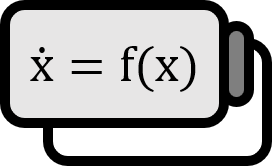Topological Equivalence between Dynamical Systems
Definition 1

$$ \left\{ T , \mathbb{R}^{n} , \varphi^{t} \right\} \\ \left\{ T , \mathbb{R}^{n} , \psi^{t} \right\} $$ Suppose we are given two dynamical systems as shown above. If there exists a homeomorphism $h : \mathbb{R}^{n} \to \mathbb{R}^{n}$ that maps each orbit of the first system to all orbits of the second system while preserving the direction of time, then the two systems are said to be topologically equivalent.
Description
As can be seen from the figure in the definition, the topological equivalence of the two systems is considered in order to see qualitative differences between the systems. Although the right system may look slightly squished compared to the left system, apart from quantitative differences such as specific numbers, the two systems essentially look the same. Mathematicians tend not to bother distinguishing such things.
Subsequent Definition 2
- Particularly, let’s say that the two systems are systems represented by maps. $$ \begin{align*} x & \mapsto f(x) \\ y & \mapsto g(y) \end{align*} $$ Then, a homeomorphism $h$ that satisfies $f = h^{-1} \circ g \circ h$ is called conjugate.
- Let’s say $h$ is a homeomorphism that exists such that the two systems are topologically equivalent. If $h, h^{-1}$ is differentiable, in other words, if $h$ is a diffeomorphism, then the two systems are said to be smoothly equivalent.
- Suppose two systems are represented as $\dot{x} = f(x)$ and $\dot{x} = g(x)$. If the smooth double function $\mu > 0$ satisfies the following, it is said to be orbitally equivalent. $$ f(x) = \mu (x) g(x) \qquad , x \in \mathbb{R}^{n} $$
- If a homeomorphism $h$ that goes from the neighborhood of the fixed point $x_{0}$ of the first system to the neighborhood of the fixed point $y_{0}$ of the second system exists and satisfies the following three conditions, the two systems are said to be locally equivalent:
- (i): $h$ is defined in the neighborhood $U \subset \mathbb{R}^{n}$ of $x_{0}$.
- (ii): $y_{0} = h \left( x_{0} \right)$
- (iii): It maps each orbit within $U$ of the first system to all orbits within $V = h(U) \subset \mathbb{R}^{n}$ of the second system while preserving the direction of time.
- A function is said to be smooth if it is differentiable and its derivative is continuous.
